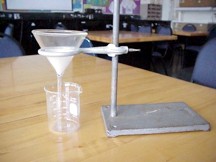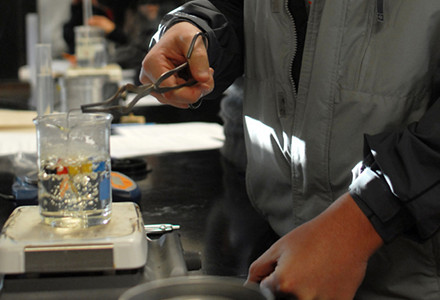Problem #3: Reaction Stoichiometry — How Can We Make Chalk?
Note: See all referenced files in the "Supplemental Files" section, at the end of this page.
Introduction:
Students will develop a process for producing Calcium carbonate (chalk) that is both cost effective and efficient. They will evaluate a variety of possible reactants for both the raw material costs and the % yield of the overall reaction. They will create a small scale process in the chemistry lab and then evaluate what it would take to scale up the process.
Learning Outcomes:
- Students will determine % yield for their selected reaction
- Students will predict the products and write balanced equations for their reaction
- Students will create a procedure that produces calcium carbonate with a minimum loss of product
- Students will understand the cost of reactants
- Students will recognize the difficulty of achieving 100% yield in a chemical reaction.
- Students will appreciate the challenges involved in producing chemicals on a manufacturing scale
Curriculum Alignment
NC SCOS
- 1.01 Design, conduct and analyze investigations to answer questions related to chemistry.
- 3.03 Calculate quantitative relationships in chemical reactions (stoichiometry)
- 5.01 Evaluate various types of chemical reactions
National Science Content Standard A: All students should develop an understanding of
- Abilities necessary to do scientific inquiry
- Understandings about scientific inquiry
National Science Content Standard B: All students should develop an understanding of
- Structure of atoms
- Structure and properties of matter
- Chemical reactions
Classroom Time Required:
2.5 class periods (85 minutes each)
Materials:
- Lab equipment typical for a high school chemistry classroom to include filter paper, funnel, graduated cylinders, distilled water wash bottles, test tubes and beakers or Erlenmeyer flasks.
- Reactants as listed in Table 1 below
Table 1: Possible Reactants
- calcium acetate monohydrate
- calcium chloride anhydrous
- calcium nitrate tetrahydrate
- ammonium carbonate anhydrous
- sodium carbonate anhydrous
- potassium carbonate anhydrous
- Table 2 attached lists approximate costs of reactants
Technology Resources:
Student Pre-activities:
- Students should have an understanding of types of reactions, mole conversions, molarity and stoichiometry.
- Students should understand how to filter a precipitate using a funnel and filter paper.
Teacher Pre-activities:
Prior to Day 1:
- Create lab groups with no more than 4 students per group. This lab assumes 8 lab groups with 4 students per group
- Prepare the 0.5 M solutions of each reactant. Table 3 provides data to prepare 200 ml of each solution
- Prepare 3- 50 ml bottles of each solutions and label these bottles.
Activities:
DAY 1: Introduce the activity to students
- Students will read the How Can We Make Chalk? student activity sheet
- Demonstrate the filtering process for students. Show them how to fold the filter paper and prepare the set up the funnel as shown in the picture below. Remind students that they will not be able to get the calcium carbonate off the filter paper. Prompt them to explain that they will need to know the mass of the filter paper prior to filtering so that they can subtract its mass from the mass of the chalk and filter paper in order to determine the mass of the chalk produced.

- A simple filtering set up is shown here.
- Students will work on the Prelab Proposal report during class. They will submit one copy of this report to the teacher prior to the end of class and retain a copy for their use on lab day.
- As the Prelab reports are submitted, the teacher will approve each groups selected reaction and record this in the Class Data Table: How Can We Make Chalk Lab. Some groups may be asked to perform a reaction other than the one they selected so that each group is performing a different reaction. This allows for data to be collected on 8 different reactions so that the most efficient can be selected from the class data.
- Prelab Proposal should contain the following as outlined on the Student Data Sheet
- List of all possible reactions that can be performed in order to produce calcium carbonate from the available reactants listed in Table 1 below. These reactions must be written as balanced equations.
- List of cost per gram of reactant for each of the possible reactants as well as the supplier. Assume you will purchase the solid and lab grade for each of the reactants.
- A procedure you will follow in order to perform these reactions. You will be given only 50.0 ml of 0.5 M solutions of your 2 reactants to use. You will need to specify in your procedure the volume of each of these solutions that you will use. Consider that you may need to perform several trials from that 50 ml sample.
- Conclude this report by stating the reaction you would most like to perform and an explanation of your choice.
DAY 2: Perform the lab
- Remind students that they should plan to run at least 3 trials and they need to determine what volume of the reactant solutions they should use in order to ensure they require no more than the 50 ml they will be given.
- Students will create a data table to hold all data collected during the lab as well as any calculated results.
- Require students to have their data tables checked and initialed by the teacher. Provide each group with 50 ml of each reactant as well as 3 sheet of filter paper. Students will perform their reactions. Be prepared to provide additional filter paper to students in case it accidentally is torn.
- Allow the filter paper to dry overnight in the classroom prior to determining the final mass.
DAY 3
- Students will record their final masses and perform their calculations of yield, % yield, Average % yield and cost per gram of calcium carbonate produced
- Students will enter their average % yield data and cost per gram of chalk data onto the class data table.
- All students need to copy the class data. The teacher may provide the Data Table to aid in this process.
- Conclude this activity with a class discussion to include the following points.
- Are there any results that do not seem to fit with the rest of the data?
- If so, what happened with that particular reaction? As a class, determine if this data can be considered valid data.
- What new techniques, ideas or concepts did you use or learn?
- Should we consider the fact that we can sell the chalk in our cost analysis for this reaction?
- Can you think of ways to improve this activity?
Assessment:
Students will be assessed on their Prelab Proposal Report using the Proposal Rubric as well as their final lab report using the Let’s Make Chalk Lab Rubric
Modifications:
This activity is written for honors chemistry students. In order to use it with academic chemistry students, it would be necessary to review the idea that a double replacement reaction which produces a precipitate will occur between your reactants. Discuss how the reactants provided can be used to produce the desired solid calcium carbonate. Have students write the 9 possible reactions with their lab groups.
Once the reactions are written, bring the class together to brainstorm possible procedures for this lab. Keep a rough outline of this procedure on the board.
At this point students can proceed with the Day 1 activities.
Academic students may also need to have the data table provided for them prior to the Day 2 activities.
Critical Vocabulary:
- Filtration:
- Filtrate:
- Precipitate:
- Theoretical Yield:
- Actual Yield:
- % Yield:

